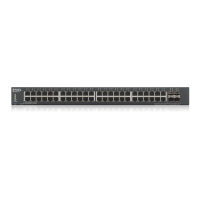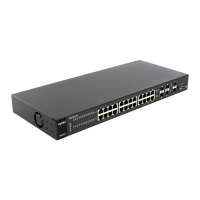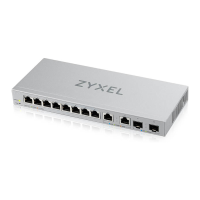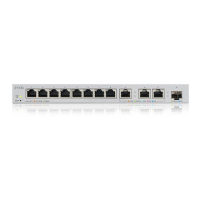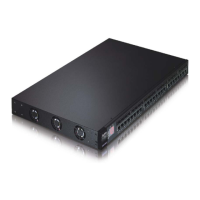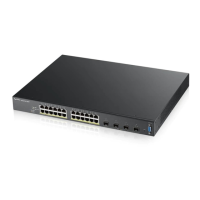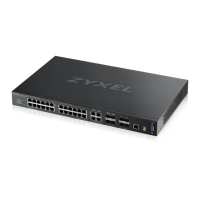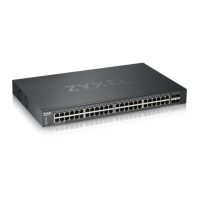
Do you have a question about the ZyXEL Communications XGS1930-38 and is the answer not in the manual?
| Model | XGS1930-38 |
|---|---|
| Type | Managed Switch |
| Ports | 38 |
| 10G SFP+ Ports | 4 |
| Gigabit Ethernet Ports | 34 |
| Power over Ethernet (PoE) | No |
| MAC Address Table | 16K |
| Layer | L2+ |
| Jumbo Frame | 9KB |
| Operating Temperature | 0°C to 50°C (32°F to 122°F) |
| Storage Temperature | -40°C to 70°C |
| Humidity | 10% to 90% non-condensing |
Introduces the switch models, management modes, features, and applications.
Details desktop and rack-mount installation procedures, including bracket attachment.
Describes the front and rear panels, ports, SFP/SFP+ slots, and grounding.
Explains accessing and using the HTML-based management interface for switch setup.
Provides steps for initial setup, including VLAN creation and IP configuration.
Guides on configuring the switch to forward DHCP client requests to a specific DHCP server.
Covers system status, Zyxel One Network utility, and neighbor management.
Details configuration of system info, general setup, switch setup, IP, PoE, interface, IPv6, and cloud management.
Explains configuring 802.1Q tagged and port-based VLANs for network segmentation.
Covers configuring forwarding rules based on MAC addresses for enhanced security.
Details configuring rules to forward specific multicast frames to designated ports.
Explains creating rules for traffic filtering based on MAC addresses and VLAN IDs.
Covers STP, RSTP, and MSTP for preventing network loops and ensuring redundancy.
Details capping maximum bandwidth for incoming and outgoing traffic flows on ports.
Explains limiting broadcast, multicast, and DLF packets per second on ports.
Describes configuring port mirroring to copy traffic for analysis.
Covers logically aggregating physical links to form one higher-bandwidth link.
Explains IEEE 802.1x and MAC authentication methods for validating port access.
Details setting up port security to allow only learned or static MAC addresses.
Allows setting up one-time and recurring schedules for time-oriented features.
Explains configuring packet classifiers for Quality of Service (QoS).
Details configuring policy rules to define actions on classified traffic flows for QoS.
Introduces supported queuing methods for managing traffic during network congestion.
Covers configuring multicast features like IGMP snooping and filtering profiles.
Describes configuring authentication, authorization, and accounting settings using RADIUS.
Explains configuring the switch to guard against loops on the network edge.
Details configuring layer 2 protocol tunneling for service provider edge devices.
Describes PPPoE termination server information and intermediate agent features.
Covers configuring rate limits for control packets and automatic error recovery.
Explains configuring the switch to reduce power consumed by switch ports.
Details advertising device identity and capabilities, and LLDP-MED features.
Covers configuring static routes for IP communication and traffic forwarding.
Explains configuring DHCP features, including relay agents for IPv4 and IPv6.
Details configuring ARP learning modes and static ARP entries for IP to MAC resolution.
Covers firmware upgrade, configuration backup, restore, and system reboot.
Describes controlling access to the switch via services like SSH, Telnet, FTP, SNMP, and logins.
Explains using the diagnostic screen for ping, traceroute, port tests, and cable diagnostics.
Covers viewing current system logs and event messages.
Details configuring system logging settings and external syslog servers.
Explains managing multiple switches through a single cluster manager switch.
Introduces the screen showing how frames are forwarded or filtered by MAC address.
Shows how packets are forwarded or filtered based on IP addresses.
Displays IP-to-MAC address mappings and allows removal of dynamic entries.
Contains route information for networks the switch can reach.
Introduces the IPv6 Path MTU table for packet transfer over data links.
Allows copying settings from one port to other ports for efficient configuration.
Displays IPv6 neighbor information and stores link-layer addresses.
Provides a port statistical summary with links to detailed statistics.
Offers suggestions to solve potential problems related to power, connections, login, and configuration.
Explains the 128-bit IPv6 address format and abbreviation rules.
Describes IPv6 prefix length for representing network addresses, similar to subnet masks.
Defines unique link-local addresses for identifying devices on a local network.
Explains globally unique IP addresses for internet identification, similar to public IPv4 addresses.
Describes the IPv6 unspecified address used when a device lacks its own address.
Defines the IPv6 loopback address for self-communication, similar to IPv4's 127.0.0.1.
Explains IPv6 multicast addresses for sending packets to groups of hosts.
Details DHCPv6 identity associations for managing client IP address assignments.
Describes the role of DHCPv6 relay agents in forwarding messages between clients and servers.
Explains how IPv6 routers use prefix delegation for LAN IP address generation.
